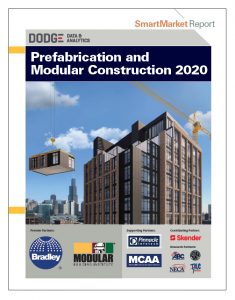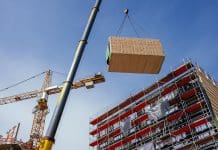Most design and construction professionals using permanent modular construction experience improved productivity and project quality, according to new research
Findings show that most design and construction professionals using permanent modular construction experience improved productivity and project quality, while the use of relocatable buildings is also expected to rise.
Dodge Data & Analytics – with the support of the Modular Building Institute – has released the findings of a landmark new study that provides a comprehensive examination of the current state and future expectations for prefabrication and modular construction.
The ‘Prefabrication and Modular Construction 2020 SmartMarket Report’ takes a close look at critical drivers, obstacles and benefits of using these methods, based on insight from architects, engineers and contractors already leveraging them.
Permanent modular construction findings
The report shows that architects, engineers, and contractors that have used modular construction plan to significantly increase their engagement with it, especially for healthcare facilities, hotels and motels, multifamily projects, and college buildings and dormitories.
Critical trends in the construction industry, such as shorter project schedules and workforce shortages, are several drivers of wider use of these methods, and technology—like Building Information Modelling (BIM)—is enabling increased use.
Tom Hardiman, executive director of the US-based Modular Building Institute, commented: “It comes as no surprise to us that more developers and GCs plan to use modular construction over the next few years.
“The lack of adequate housing and the shortage of skilled labour, coupled with chronic cost and schedule overruns are leading more people towards this process.”
Drivers and obstacles of modular
In order to better understand the critical drivers and obstacles for using these methods and the benefits achieved, the study focuses on the architects, engineers, and contractors that are already using them.
When it comes to benefits of use:
- 99% of GCs/CMs, 92% of architects/engineers, and 89% of trade contractors report that they achieve improved productivity when using modular construction compared to traditional stick-built construction.
- 92% of GCs/CMs, 91% of architects/engineers, and 85% of trade contractors report that they achieve increased schedule certainty when using modular construction.
- 92% of architects/engineers, 90% of GCs/CMs, and 88% of trade contractors report that they achieve improved quality when using modular construction.
- Improved schedule performance, improved cost predictability, and increased client satisfaction were identified as other top drivers behind the use of modular construction.
The most interesting growth is expected in practices less widely used now:
- Prefabricated multi-trade assemblies, which involve the work of several trades combined together (such as a corridor rack in a hospital) will be used by 58% of those doing prefabrication in general – up dramatically from the 33% using this approach now.
- Equally, dramatic growth is seen among those doing modular construction in the use of full volumetric approach, in which entire parts of buildings (such as bathrooms or hotel and hospital rooms) are delivered preconstructed onsite and assembled together. A striking 61% expect to employ that method at least 10% of their projects in the next three years, up from just 44% of those doing modular construction who report using this method currently.
When it comes to the top factors that influenced the use of permanent modular construction:
- Over the past three years, the desire to improve productivity has been the most influential factor overall with 78% of GCs/CMs, 65% of trade contractors, and 53% or architects/engineers indicating as such.
- Notably larger percentages of GCs/CMs cite the influence of workforce shortages (51%), safety (59%), and productivity (78%) than do other types of companies, clearly identifying these as top drivers for that group.
- Trades lead in identifying the need to remain competitive (60%), and being competitive is the second most influential factor overall.
The use of relocatable modular buildings is also expected to rise over the next three years.
- GCs/CMs are the current leaders (71%) in using relocatable modular buildings, and more (79%) believe they will be doing so in the next three years.
- All respondents anticipate double-digit percentage growth in the use of relocatable modular buildings in at least 25%-49% of projects.
- Two-thirds (66%) of design firms report some level of usage.
The use of BIM is also tied to the experience of those benefits. Among those using BIM on the majority of their projects, 60% credit it with improving the schedule performance of their prefabricated or modular projects, and 50% with improving budget performance.
Steve Jones, senior director of industry insights at Dodge Data and Analytics, said: “BIM improves the prefabrication and modular process by providing the means to accelerate the design early enough to take advantage of these approaches and then offering certainty during the entire process.
“Having these tools helps enable the industry to invest more in the use of multi-trade assemblies and volumetric construction, in particular, and may be contributing to the strong growth expected in these areas.”
The greatest growth in the use of permanent modular construction will be in building types in which they are already well established, such as healthcare facilities, hotels and motels, multifamily and college buildings and dormitories. However, a sizable percentage also expects low-rise offices, K-12 schools, public buildings and commercial warehouse to experience a high frequency of use of prefabrication or modular construction.
The Prefabrication and Modular Construction 2020 SmartMarket Report is available for free download here.














